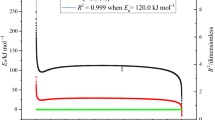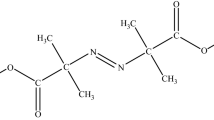Abstract
Azo compounds are widely used in dyes, pigments, blowing agents, and initiators. Unfortunately, these compounds contain the bivalent –N–N– composition which might be cleavaged readily even under high ambient temperature. The self-accelerating decomposition might cause a runaway reaction and lead to a fire or explosion when the cooling system fails or other upsets occur. To investigate the thermal stability parameters of 2,2′-azobis(isobutyronitrile) with thermal hazard and mechanism, differential scanning calorimetry and thermal activity monitor III were applied with non-isothermal method and isothermal method to obtain onset temperature (T 0), maximum temperature (T max), and heat of decomposition (ΔH d). Thermal stability parameters play a pivotal role in thermal analysis, leading particularly to complex evaluation of the inherently safer design during preparation, processing, transport, or storage. The results provide sufficient thermokinetic parameters for process safety in terms of proactive loss prevention program.








Similar content being viewed by others
Abbreviations
- E a :
-
Apparent activation energy (kJ mol−1)
- ∆H d :
-
Heat of decomposition (J g−1)
- ∆H f :
-
Heat of fusion (J g−1)
- Q max :
-
Maximum peak power at time (W g−1)
- R :
-
Ideal gas law constant (8.31415 J K−1 mol−1)
- T 0 :
-
Onset temperature (°C)
- T p :
-
Peak temperature (°C)
- T max :
-
Maximum temperature (°C)
- T me :
-
Melting temperature (°C)
- T mf :
-
Fusion temperature (°C)
- TMRiso :
-
Time to maximum rate under isothermal conditions (h)
- β :
-
Heating rate (°C min−1)
References
Li XR, Wang XL, Koseki H. Study on thermal decomposition characteristics of AIBN. J Hazard Mater. 2008;159:13–8.
Li XR, Koseki H. SADT prediction of autocatalytic material using isothermal calorimetry analysis. Thermochim Acta. 2005;431:113–6.
Li XR, Koseki H. Study on the early stage of runaway reaction using Dewar vessels. J Loss Prev Process Ind. 2005;18:460–4.
Ng WL. Thermal decomposition in the solid state. Aust J Chem. 1975;28:1169–78.
Van Hook JP, Tobolsky AV. The thermal decomposition of 2,2′-azo-bis-isobutyronitrile. J Am Chem Soc. 1975;80:779–82.
Ho SK. The thermal decomposition of azo-compounds in solution. Pokfulam: The University of Hong Kong; 1960.
Gowda S, Abiraj K, Channe Gowda D. Reductive cleavage of azo compounds catalyzed by commercial zinc dust using ammonium formate or formic acid. Tetrahedron Lett. 2002;43:1329–31.
Sun CK, Zhao HM, Fang DC, Li ZH. Theoretical study on the thermal decomposition of azoisobutyronitrile. J Mol Struct. 2004;679:89–94.
Dubikhin VV, Knerel’man EI, Manelis GB, Nazin GM, Prokudin VG, Stashina GA, Chukanov NV, Shastin AV. Thermal decomposition of azobis(isobutyronitrile) in the solid state. Kinet Catal. 2012;446:171–5.
Partington S, Waldram SP. Runaway reaction during production of an azo dye intermediate. IChemE. 2002;80:33–9.
Talat E, Bywate S. The thermal decomposition of 2,2′-azo-bis-isobutyronitrile. J Am Chem Soc. 1954;77:3712–4.
Steensma M, Schuurman P, Malow M, Krause U, Wehrstedt KD. Evaluation of the validity of the UN SADT H.4 test for solid organic peroxides and self-reactive substances. J Hazard Mater. 2005;A117:89–102.
Chen KY, Wu SH, Wang YW, Shu CM. Runaway reaction and thermal hazards simulation of cumene hydroperoxide by DSC. J Loss Prev Process Ind. 2008;21:101–9.
STARe Software with Solaris Operating System. Operating instructions. Zurich: Mettler Toledo; 2004.
Liu SH, Lin CP, Shu CM. Thermokinetic parameters and thermal hazard evaluation for three organic peroxides by DSC and TAM III. J Therm Anal Calorim. 2011;106:165–72.
Weng SY, Liu SH, Tsai LC, Hsieh TF, Ma CM, Shu CM. Thermokinetics simulation for multi-walled carbon nanotubes with sodium alginate by advanced kinetics and technology solutions. J Therm Anal Calorim. 2013;. doi:10.1007/s10973-013-3092-5.
Chu YC, Chen JR, Tseng JM, Tsai LC, Shu CM. Evaluation of runaway thermal reactions of di-tert-butyl peroxide employing calorimetric approaches. J Therm Anal Calorim. 2011;106:227–34.
Product Information. TAM III Thermostat. 2013. http://www.tainstruments.com/.
Tseng JM, Liu MY, Chen SL, Hwang WT, Gupta JP, Shu CM. Runaway effects of nitric acid on methyl ethyl ketone peroxide by TAM III test. J Therm Anal Calorim. 2009;96:789–93.
Tseng JM, Chang YY, Su TS, Shu CM. Study of thermal decomposition of methyl ethyl ketone peroxide using DSC and simulation. J Hazard Mater. 2007;142:765–70.
Townsend DI, Tou JC. Thermal hazard evaluation by an accelerating rate calorimeter. Thermochim Acta. 1980;37:1–30.
Tseng JM, Shu CM. Isothermal kinetic evaluation of methyl ethyl ketone peroxide mixed with acetone by TAM III tests. Thermochim Acta. 2010;507–8:45–8.
Tsai YT, You ML, Qian XM, Shu CM. Calorimetric techniques combined with various thermokinetic models to evaluate incompatible hazard of tert-butyl peroxy-2-ethyl hexanoate mixed with metal ions. Ind Eng Chem Res. 2013;52:8206–15.
Jhu CY, Wang YW, Wen CY, Shu CM. Thermal runaway potential of LiCoO2 and Li (Ni1/3Co1/3Mn1/3)O2 batteries determined with adiabatic calorimetry methodology. Appl Energy. 2012;100:127–31.
Brauner N, Shacham M. Statistical analysis of linear and nonlinear correlation of the Arrhenius equation constants. Chem Eng Process. 1997;36:243–9.
Torfs JCM, Deij L, Dorrepaal AJ, Heijens JC. Determination of Arrhenius kinetic constants by differential scanning calorimetry. Anal Chem. 1984;56:2863–7.
Vyazovkin S. Mechanism and kinetics of epoxy–amine cure studied by differential scanning calorimetry. Macromolecules. 1996;29:1867–73.
Acknowledgements
The authors are indebted to the donors of the National Science Council (NSC) in Taiwan under the Contract Number NSC101-2221-E-407-001-MY3 for financial support.
Author information
Authors and Affiliations
Corresponding author
Rights and permissions
About this article
Cite this article
Liu, SH., Yu, YP., Lin, YC. et al. Complex thermal evaluation for 2,2′-azobis(isobutyronitrile) by non-isothermal and isothermal kinetic analysis methods. J Therm Anal Calorim 116, 1361–1367 (2014). https://doi.org/10.1007/s10973-013-3632-z
Received:
Accepted:
Published:
Issue Date:
DOI: https://doi.org/10.1007/s10973-013-3632-z




